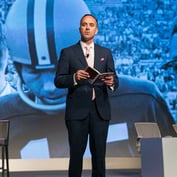(Bloomberg) — When Hostess Brands Inc. went bankrupt in 2012, it triggered anxiety among employees at Ottenberg’s Bakery, a family-owned enterprise in Maryland. The companies shared a pension plan, and if Hostess couldn’t pay its retirees, Ottenberg’s would have to pick up the tab.
Gary League, 53, who has delivered Ottenberg’s bread for almost three decades, worried he might lose his nest egg, maybe even his job.
“If you have all these guys out on retirement and you only have Ottenberg’s paying into it, the math doesn’t add up,” League said. “I was thinking I would have to work forever.”
Last week, he got the good news — the U.S. government saved his benefits by sacrificing those of Hostess’ drivers, who will now get a reduced payout financed by the government.
League is one of 10.4 million Americans with retirements tied to multi-employer pension plans, large investment pools long considered low risk because they don’t rely on a single company for financing. Two recessions, industry consolidation prompted by deregulation, and an aging workforce have funds facing a $400 billion shortfall that has some near insolvency. Dozens already have failed, affecting 94,000 participants.
Things are dire enough that a coalition of employers and labor unions is asking Congress for permission to cut benefits to retired truck drivers, miners and others as a last resort in order to prevent plans from going under. The proposal has divided unions and their allies, triggering a lobbying battle as a legislative deadline approaches and retirement security looms large as a growing economic concern.
Hostess bankruptcy
Hostess, maker of Wonder Bread and Twinkies, was one of two employers contributing to the Bakery and Sales Drivers Local 33 Pension Fund. When Hostess went bankrupt, Ottenberg’s, a 140- year-old family operation near Baltimore, was left to foot the bill. President Ray Ottenberg didn’t respond to requests for comment.
Hostess had about $2 billion in liability to its multiemployer plans. Because of the bankruptcy, those pensions will get nothing from the company, said David Rush, chief financial officer of the Hostess estate, known as Old HB Inc.
“You have to repay your secured creditors first,” he said. “It was an unfortunate situation.”
The Obama administration acted last month, taking 342 Hostess truck drivers out of the plan to rescuebenefits for League and about 360 others. It was the third time in its 40- year history that the Pension Benefit Guaranty Corp. had carved up a fund.
PBGC action
The PBGC engineered a merger of Ottenberg pensions into another plan and Local 33 went under. Since 2005, the agency has paid about $722 million to people in similar failed plans.
A coalition of 40 labor and employer groups, including Bechtel Group Inc., United Parcel Service Inc. and — at the time — the International Brotherhood of Teamsters, last year said pension trustees should be allowed to cut benefits to current retirees. The once-unthinkable idea is now gaining support as funds falter and unemployment, student debt and longer life spans leave people less financially prepared for retirement.
“It’s the first attempt by an industry or a sector of the economy to really address what’s going to come back and bite us as a country,” said Randy DeFrehn, executive director of the National Coordinating Committee for Multiemployer Plans in Washington and an author of its “Solutions Not Bailouts” report. “If you allow some of these plans to have flexibility, they can take action instead of waiting until the assets are depleted.”
Slippery slope
Others disagree. Giving pensions that option would make the problem worse, and not just for retirees, said Teresa Ghilarducci, an economist at The New School for Social Research in New York. Multiemployer payments are low and concentrated in economically distressed regions, including the industrial Midwest, she said.
Once some pensions get the flexibility to cut benefits, others will want it, too, she said. It’s a slippery slope that could lead to changes at single-employer pensions, which have 30.4 million participants.
“It’s bad for households, but it’s also bad for the economy,” Ghilarducci said. “In some of these communities, it’s the retirees that are the mainstay.”
The PBGC, created in 1974, is on uneasy financial footing itself. The agency charges companies in multiemployer plans an annual insurance premium of $12 per plan participant, less than one-fourth of what other pension plans pay. The agency projects 173 multiemployer plans will exhaust assets, costing it an estimated $10 billion and leading to the insurance program’s insolvency in 10 to 15 years.
Bigger premiums
The agency is asking Congress for an increase in insurance premiums and more ability to intervene before funds are insolvent.
Although the Hostess partition will cost the agency an estimated $22.5 million, it could ultimately save money because the entire pension plan likely would have failed without it, PBGC Director Joshua Gotbaum said.
The agency partitioned its first pension in 1983 to save benefits for restaurant workers and manufacturers in and around Detroit. In 2010, it split a Chicago plan, protecting 3,700 truckers and putting 1,500 on government payouts. Now it’s weighing carving up a second Hostess-related fund.
“After we announced the Hostess partition we got calls from folks in other plans saying what about us?” Gotbaum said in an interview. “If we had a lot more money, we could do a lot more plans.”








 February 26, 2014 at 06:09 AM
February 26, 2014 at 06:09 AM









